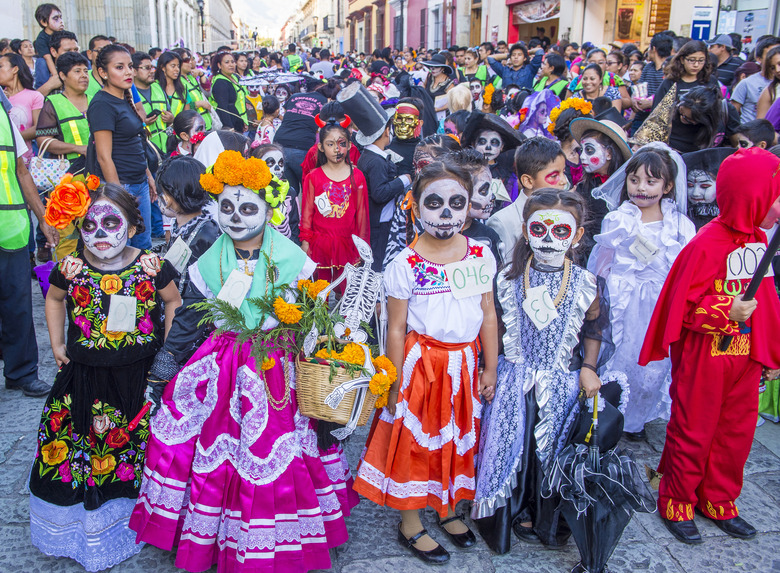Celebrating The Day Of The Dead In Oaxaca
With a simple cloth draped over an everyday table, the transformation from dinner table to home altar morphs before my eyes. Photographs of the departed, personal letters, drawings, Day-Glo orange flowers, fruits, candles, cutout tissue paper banners, sugar skulls painted with neon icing, fanciful skeletons, and assorted holiday whimsy are layered on top. And the 10-foot sugarcane stalks I helped carry back from the market are tied into an arch to enclose sacred wall space.
Favorite foods and drinks of the deceased are lovingly arranged, like plates of tamales, mugs of hot chocolate, mezcal, decorative breads, candies, roasted peanuts, and snacks. (These foods are never eaten post-holiday because they are tasteless after visiting spirits enjoy them.) Candles are lit and the room is suddenly filled with magic. It's the same breathtaking gasp we all take when Christmas tree lights are switched on for the first time.
Modern Mexican El Día de los Muertos (Day of the Dead) festivities stem from ancient indigenous religions intertwined with Spanish colonial Catholicism. Families file into cemeteries the night of October 31st through All Saint's Day, November 1st, to embellish graves, especially those of children. They visit again on All Soul's Day, November 2nd, to remember deceased adults. Groups often spend both nights graveside among hundreds of candles and fluorescent marigolds that light the way for spirits of loved ones coming back for the holiday. The smoky scene is surreal. After sunrise, everyone's off to church before gathering at home for traditional foods of mole, tamales, and hot chocolate.
The Spanish colonial city of Oaxaca is one of the best places to spend the Day of the Dead. El Camino Real, the well-known restored ex-convent hotel, is pricey for the holiday and the few ample, quiet rooms are often reserved a year in advance. On a hilltop perch overlooking the city lights, Oaxaca's other large hotel, Hotel Victoria Oaxaca, could use some renovation, but a drink at its bar (with music by trio Yullinehui) is top-notch. Both hotels remain stellar for breakfast and brunch, and for their brilliantly decorated altars. Small hotels and B&Bs are where I prefer to stay: Casa Oaxaca, Hotel de la Parra, Casa de Sierra Azul, and Las Bugambilias B&B (plus the family's other B&B locations) are within the central area.
Must-go places to eat are any of chef Alejandro Ruiz's modern cuisine spots: Casa Oaxaca Hotel's restaurant (romantic, upscale), Casa Oaxaca El Restaurante (with rooftop bar), and Casa Oaxaca Café. Take a taxi uphill to Colonia Reforma for super casual Itanoni for regional tetelas and quesadillas made with heritage corn (its bio-chemist owner is a Slow Food member).
Another favorite is La Olla for chef Pilar Cabrera's always fresh, midday meal. Try any of the seafood cocktails at Marco Polo, on Llano Park, and their wood oven-baked red snapper — a world-class dish. For traditional, home-style cooking I love sitting at a marketplace counter and ordering whatever looks good bubbling away in a clay cazuela. One of the all-time best is chilaquiles verdes (green sauce) at Fonda Rosita in the Democracía (a.k.a. Merced) market. Street food at its finest can be found at night on Libres near the corner of Murguia where clouds of smoke char meats for pizza-like clayudas. When I need a break from the sometimes-frenzied festivities (firecrackers set off in church yards, parades of the devout in costumes, and wafts of intense copal incense), I head outside the city center and pass a lazy afternoon with friends under a palapa at La Capilla in Zaachila where Zapotec cooking rules supreme. ¡Buen provecho!
Nancy Zaslavsky is an author, culinary tour leader, and cooking teacher who specializes in the foods of Mexico. Click here to find out more about her recipes, books, cooking demonstrations, and tours.
